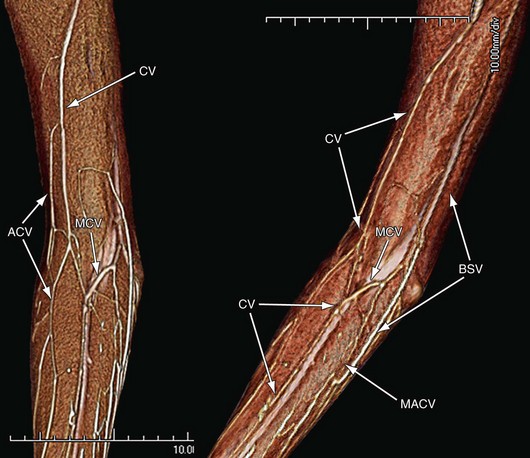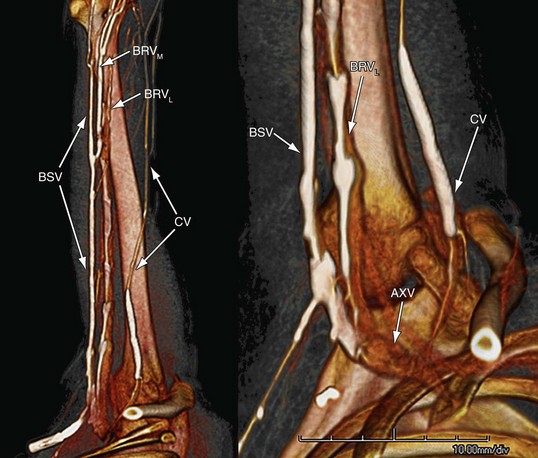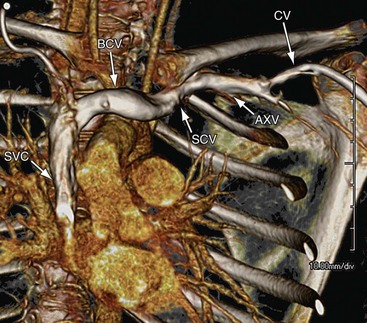CHAPTER 77 Venous Anatomy of the Extremities
The upper and lower extremity peripheral venous systems comprise three main types of veins—superficial, deep, and perforating. The superficial and deep subsystems are defined by major and tributary veins linked by the perforating veins as well as venous networks (plexi), with the goal of directing all venous blood return into the deep system in peripheral, mid, or central extremity venous segments. Wide variability is often encountered in this anatomy, with origins for both systems beginning peripherally at the hand or foot for the upper and lower extremities, respectively. The superficial veins are located subcutaneously within the superficial fascia. The deep veins are located intramuscularly, deep to the superficial fascia, accompanying the extremity arteries (venae comitans). Perforating veins cross the muscular fascial layer, typically bridging flow from superficial to deep veins. Valves function in superficial, deep, and perforating veins to keep blood flowing antegrade and prevent blood flowing from the deep to superficial veins. Valves are more prevalent in the deep veins for both the upper and lower extremities.1–5
In general, the extremity veins are thin wall structures with little to no elastic lamina, resulting in passive distensible conduits with large compliance. The deep veins, however, inherit strength directly by having a greater degree of elastic lamina and indirectly by way of muscular contractions, countering gravity and central venous filling pressures to propagate blood flow toward the central veins and heart.5–6 The well-orchestrated anatomic physiology between the deep venous pumps, valves, and perforating veins becomes particularly apparent in the setting of elevated central venous pressures, incompetent valves, immobility, obstructed central or deep extremity veins, or a combination of these conditions.
UPPER EXTREMITY
Veins for the upper extremity direct blood flow from the hand, wrist, forearm, upper arm, and shoulder to the ipsilateral central thorax veins and ultimately the superior vena cava. In the hand, forearm, and upper arm, the superficial system functions as the principal means for venous drainage. As a result, the caliber of the superficial veins is generally larger than the deep veins. The major superficial veins of the hand, forearm, and upper arm exist as single structures and infrequently have accessory veins. The smaller deep veins occur in pairs, alongside the respective arteries. All upper extremity venous drainage transitions to the deep system at the axilla, with a single main venous channel crossing the costoclavicular space into the thoracic central venous system. Within the axillae and thorax, the major deep veins occur as single structures, accompanying the adjacent artery.7–10
Superficial Veins of the Upper Extremity
The dorsal veins include the dorsal digital veins, dorsal metacarpal veins, and dorsal venous network (plexus). Dorsal digital veins form by coalescence of dorsal distal digital venules and venous arches, and extend bilaterally along the length of dorsum of the fingers. They communicate at multiple levels via small oblique venous connections. The dorsal digital veins from the ulnar aspect of the index finger, radial aspect of the fifth finger, and both sides of the third and fourth fingers, along with intercapitular veins between the digits, drain into three superficial dorsal metacarpal veins. The metacarpal veins, in turn, feed into the dorsal venous network, which is located at the mid and base of the metacarpals (Fig. 77-1).9
Along the radial aspect of the hand, the dorsal venous network receives dorsal veins of the thumb and dorsal vein of the radial aspect of the index finger and continues with cephalad drainage, forming the cephalic vein. Along the ulnar aspect of the hand, the dorsal venous plexus receives the dorsal vein from the ulnar aspect of the fifth finger and continues with cephalad drainage, forming the basilic vein. The median portion of the network variably may drain to the mid-forearm cephalic vein via a communicating (accessory) vein (Fig. 77-2).8
The palmar veins of the hand include palmar digital veins and palmar venous plexus. Palmar digital veins parallel the dorsal digital veins, along the palmar surface. There are three routes of drainage for the palmar digital veins. Two are within the superficial system and include the palmar venous network and dorsal digital and metacarpal veins. The palmar venous network lies at the thenar and hypothenar eminences and drains primarily into the median antecubital vein of the forearm. Drainage into the dorsal digital veins and dorsal metacarpal veins occurs by way of intercapitular veins in the digital web spaces at the metacarpal heads. The third route is into the common and metacarpal palmar veins of the palmar deep system.2,3
In the forearm, main superficial venous drainage occurs via the cephalic, basilic, and median antecubital veins (Fig. 77-3). The cephalic and basilic veins ascend to the elbow along the radial and ulnar aspects of the forearm, respectively, with continuation into the upper arm. The cephalic vein, basilic vein, or both, may form the dominant drainage route into the upper arm.
The cephalic vein transitions from the dorsal to volar surfaces in the distal third of the forearm. Along its course in the forearm, the cephalic vein receives dorsal and volar tributaries. Just proximal to the elbow, the cephalic vein gives off the median basilic vein, which ascends obliquely over the volar surface, crosses the antecubital fossa, and drains into the basilic vein. The cephalic vein then crosses the ventrolateral aspect of the elbow, in a groove between the brachioradialis and biceps brachii muscles. An accessory cephalic vein is often present, with variable morphology. Most commonly, it arises from the dorsal venous plexus or from a dorsal forearm tributary network and courses along the radial aspect of the forearm, lateral to the cephalic vein. It drains into the cephalic vein below the elbow. Alternatively, the accessory cephalic vein may form a venous bridge between cephalic vein segments below and above the elbow. The accessory cephalic vein often supplies a dorsal oblique branch, forming a second level of communication between the cephalic and basilic veins within the forearm.8
In the upper arm, the basilic and cephalic veins are the major routes for superficial venous drainage, with ultimate runoff into the deep system (Figs. 77-4 and 77-5). The basilic vein is typically larger than the cephalic vein, coursing medial to the biceps brachii. The smaller cephalic vein courses lateral to the biceps brachii. The basilic vein ascends initially within the superficial fascia, but then perforates the deep fascia at the midarm level. Subsequent to this, the basilic vein courses along the medial aspect of the brachial artery until the inferior margin of the teres major muscle, at which point it joins the brachial vein (deep system) to form the axillary vein (deep system). The cephalic vein ascends completely within biceps superficial fascia, entering the infraclavicular fossa between the pectoralis major and deltoid muscles.8 It then courses medial, in the clavipectoral triangle, entering the cranial aspect of the central axillary vein with acute angulation, below the clavicle. The cephalic veins typically have a valve just proximal to its junction with the axillary vein.
Deep Veins of the Upper Extremity
In the hand, the superficial and deep palmar venous arches form the most peripheral major venous conduits of the upper extremity deep system. Usually duplicated with interconnections between each individual pair of arches, the palmar arches parallel the arterial arches and receive drainage corresponding to the respective arterial arch branches. These include common palmar digital veins for the superficial palmar venous arch and palmar metacarpal veins for the deep venous arch. The palmar metacarpal veins also communicate with the dorsal metacarpal veins via perforating veins, forming a means for the deep palmar venous arch to drain the dorsal metacarpal veins as well. The superficial palmar arch courses to the ulnar side of the wrist and drains into ulnar veins, whereas the deep palmar venous arch courses to the radial side of the wrist and drains into radial veins. Branches from the deep palmar arches and the proximal ulnar and radial veins form a carpal venous plexus, which drains into the volar and dorsal interosseous veins.4


 FIGURE 77-1
FIGURE 77-1
 FIGURE 77-2
FIGURE 77-2
 FIGURE 77-3
FIGURE 77-3
 FIGURE 77-4
FIGURE 77-4
 FIGURE 77-5
FIGURE 77-5